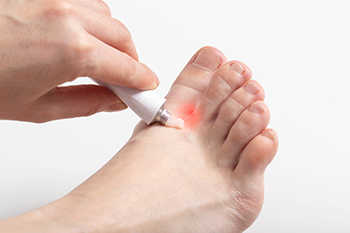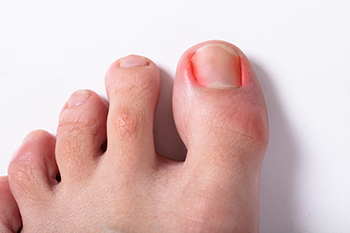
Athlete’s foot is a common fungal skin infection that affects the feet, particularly the areas between the toes and the soles. It develops when fungi thrive in warm and moist environments, leading to irritation of the skin. Symptoms often include itching, burning, redness, peeling, and occasional blistering. Risk factors include excessive sweating, wearing tight or non-breathable footwear, walking barefoot in public areas, and having a weakened immune system. Causes may involve prolonged moisture exposure, poor foot hygiene, or contact with contaminated surfaces. A podiatrist can help by accurately diagnosing the condition and prescribing effective antifungal treatments. If you notice persistent itching or skin changes on your feet, it is suggested that you consult a podiatrist who can offer effective relief and treatment solutions.
Athlete’s foot is an inconvenient condition that can be easily reduced with the proper treatment. If you have any concerns about your feet and ankles, contact Arnold Farbstein, DPM from Texas. Our doctor will treat your foot and ankle needs.
Athlete’s Foot: The Sole Story
Athlete's foot, also known as tinea pedis, can be an extremely contagious foot infection. It is commonly contracted in public changing areas and bathrooms, dormitory style living quarters, around locker rooms and public swimming pools, or anywhere your feet often come into contact with other people.
Solutions to Combat Athlete’s Foot
- Hydrate your feet by using lotion
- Exfoliate
- Buff off nails
- Use of anti-fungal products
- Examine your feet and visit your doctor if any suspicious blisters or cuts develop
Athlete’s foot can cause many irritating symptoms such as dry and flaking skin, itching, and redness. Some more severe symptoms can include bleeding and cracked skin, intense itching and burning, and even pain when walking. In the worst cases, Athlete’s foot can cause blistering as well. Speak to your podiatrist for a better understanding of the different causes of Athlete’s foot, as well as help in determining which treatment options are best for you.
If you have any questions please feel free to contact our office located in Houston, TX . We offer the newest diagnostic and treatment technologies for all your foot and ankle needs.
 A toenail that grows into the skin on the sides of the toe is known as an ingrown toenail. Research has shown that a baby's toenails are soft and pliable, and if it is accompanied by swelling and redness, it may be an ingrown toenail. Additional symptoms of this condition can include pain and difficulty keeping shoes on. Some of the reasons this ailment may occur can consist of trimming the toenails incorrectly, wearing shoes that are too tight, and it may run in families. Your child’s foot may feel better when it is soaked in warm water, and the swollen area is gently massaged. If your child has these symptoms, it is strongly suggested that you consult with a podiatrist who can guide you toward proper treatment techniques.
A toenail that grows into the skin on the sides of the toe is known as an ingrown toenail. Research has shown that a baby's toenails are soft and pliable, and if it is accompanied by swelling and redness, it may be an ingrown toenail. Additional symptoms of this condition can include pain and difficulty keeping shoes on. Some of the reasons this ailment may occur can consist of trimming the toenails incorrectly, wearing shoes that are too tight, and it may run in families. Your child’s foot may feel better when it is soaked in warm water, and the swollen area is gently massaged. If your child has these symptoms, it is strongly suggested that you consult with a podiatrist who can guide you toward proper treatment techniques.
Ingrown toenails may initially present themselves as a minor discomfort, but they may progress into an infection in the skin without proper treatment. For more information about ingrown toenails, contact Arnold Farbstein, DPM of Texas. Our doctor can provide the care you need to keep you pain-free and on your feet.
Ingrown Toenails
Ingrown toenails are caused when the corner or side of a toenail grows into the soft flesh surrounding it. They often result in redness, swelling, pain, and in some cases, infection. This condition typically affects the big toe and may recur if it is not treated properly.
Causes
- Improper toenail trimming
- Genetics
- Improper shoe fitting
- Injury from pedicures or nail picking
- Abnormal gait
- Poor hygiene
You are more likely to develop an ingrown toenail if you are obese, have diabetes, arthritis, or have any fungal infection in your nails. Additionally, people who have foot or toe deformities are at a higher risk of developing an ingrown toenail.
Symptoms
Some symptoms of ingrown toenails are redness, swelling, and pain. In rare cases, there may be a yellowish drainage coming from the nail.
Treatment
Ignoring an ingrown toenail can have serious complications. Infections of the nail border can progress to a deeper soft-tissue infection, which can then turn into a bone infection. You should always speak with your podiatrist if you suspect you have an ingrown toenail, especially if you have diabetes or poor circulation.
If you have any questions, please feel free to contact our office located in Houston, TX . We offer the newest diagnostic and treatment technologies for all your foot care needs.

Foot and ankle injuries in snowboarding often occur because both feet are attached to a single board, reducing independent movement and increasing stress during falls or sharp turns. Non-releasable bindings can lock the feet in place, leading to sprains, fractures, and tendon strains. Boots and hybrid boots that do not fit well may add pressure, reduce stability, or fail to protect the ankles during landings. These factors can place significant force on the lower limbs, especially on uneven terrain or during high-speed maneuvers. A podiatrist can evaluate injuries, provide proper treatment, and recommend supportive gear that improves safety. If you have foot pain after snowboarding, it is suggested that you seek professional care from a podiatrist who can provide effective relief and treatment solutions.
Sports related foot and ankle injuries require proper treatment before players can go back to their regular routines. For more information, contact Arnold Farbstein, DPM of Texas. Our doctor can provide the care you need to keep you pain-free and on your feet.
Sports Related Foot and Ankle Injuries
Foot and ankle injuries are a common occurrence when it comes to athletes of any sport. While many athletes dismiss the initial aches and pains, the truth is that ignoring potential foot and ankle injuries can lead to serious problems. As athletes continue to place pressure and strain the area further, a mild injury can turn into something as serious as a rupture and may lead to a permanent disability. There are many factors that contribute to sports related foot and ankle injuries, which include failure to warm up properly, not providing support or wearing bad footwear. Common injuries and conditions athletes face, including:
- Plantar Fasciitis
- Achilles Tendinitis
- Achilles Tendon Rupture
- Ankle Sprains
Sports related injuries are commonly treated using the RICE method. This includes rest, applying ice to the injured area, compression and elevating the ankle. More serious sprains and injuries may require surgery, which could include arthroscopic and reconstructive surgery. Rehabilitation and therapy may also be required in order to get any recovering athlete to become fully functional again. Any unusual aches and pains an athlete sustains must be evaluated by a licensed, reputable medical professional.
If you have any questions please contact our office located in Houston, TX . We offer the newest diagnostic and treatment technologies for all your foot and ankle needs.

